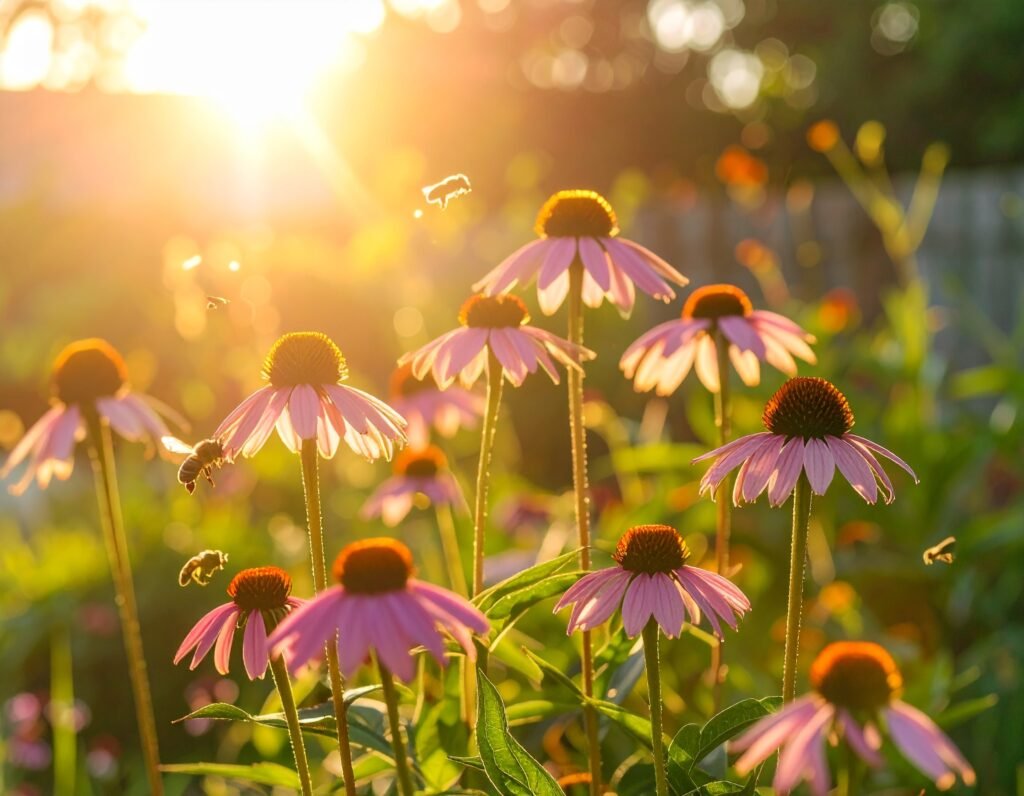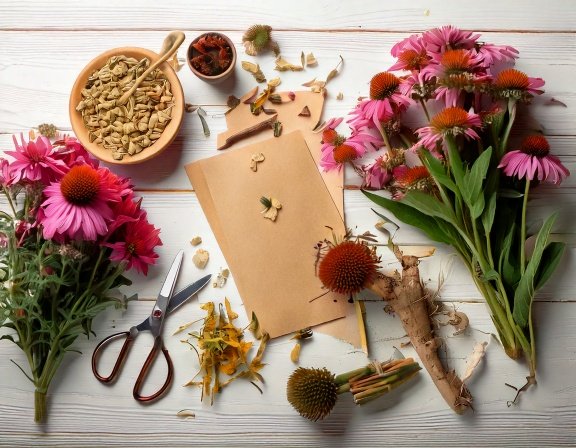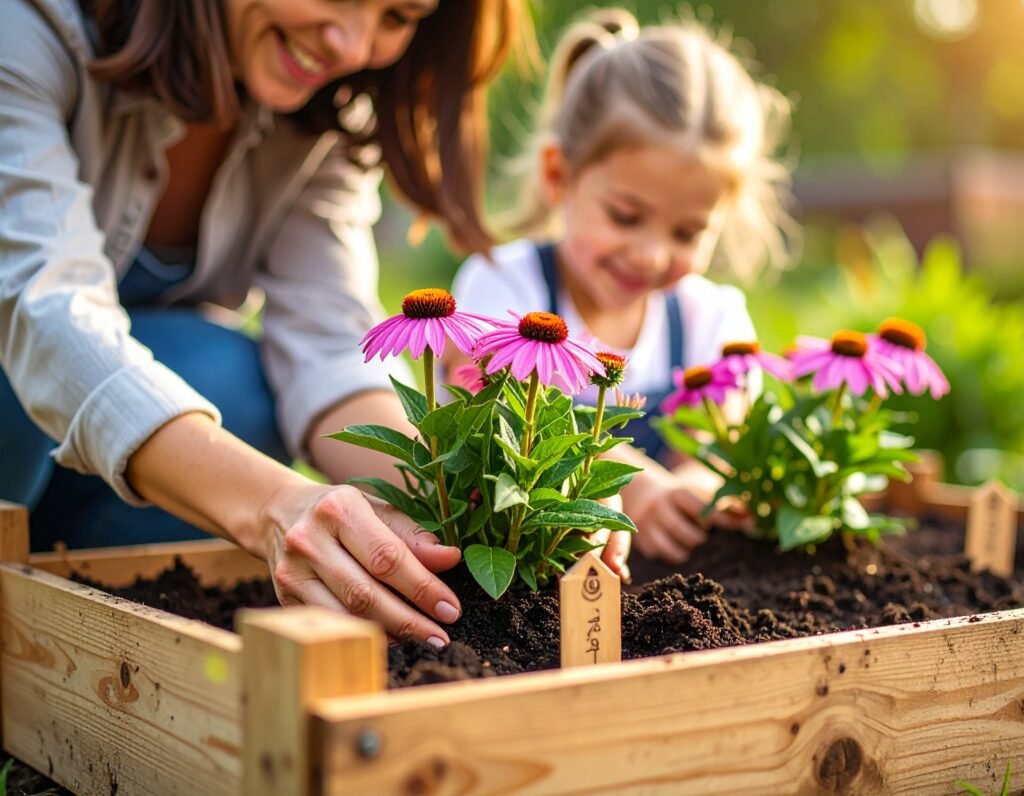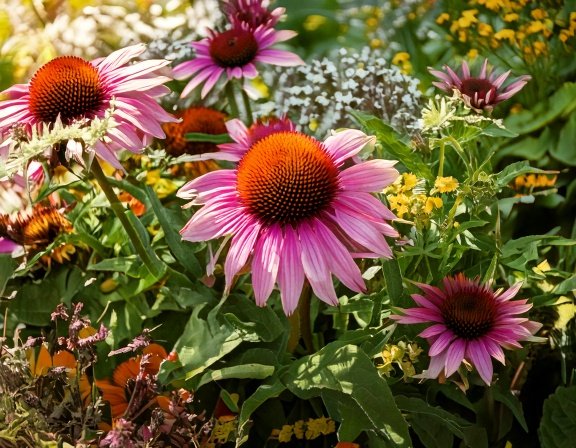Echinacea Benefits: How to Grow, Harvest and Boost Immunity at Home

IMMUNITY GARDEN PLANNER (PDF)
Grow your own wellness—calendar, garden layouts, and 12 must-have immune-boosting plants from seed to tea.
Download Free Guide
If you could grow your own immune defense, would you? Echinacea — also known as the purple coneflower — is more than just a pretty face in the garden. For centuries, this powerful herb has been used to fight infections, reduce inflammation, and help the body ward off illness. In this guide, you’ll discover how to grow echinacea at home and use it to support your immunity.
What Is Echinacea?
Echinacea is a North American native wildflower with deep healing roots. Indigenous tribes and herbalists have used it for everything from snake bites to infections. Today, modern science confirms that echinacea contains compounds like alkamides, flavonoids, and polysaccharides that activate immune cells and support overall wellness.
Types to Know
- Echinacea purpurea – most common and easiest to grow
- Echinacea angustifolia – potent but harder to cultivate
- Echinacea pallida – more ornamental, still useful
Key Benefits of Echinacea
Insta Soothe: Capsaicin, Arnica & Turmeric Relief Cream
- Features plant-powered actives: Capsaicin, Arnica, Turmeric, Boswellia Serrata
- Menthol and MSM for soothing coolness and mobility
- No harsh chemicals—just natural comfort for your joints

Growing Echinacea at Home
“A garden is a living pharmacy for the soul.” Few plants embody this better than echinacea—a resilient, immune-boosting perennial that adds both color and purpose to your garden. Known for its purple coneflowers and healing roots, echinacea is as beautiful as it is beneficial.
Sunlight and Soil
Echinacea thrives in full sun and well-drained soil. It can tolerate poor soil conditions but prefers a loamy mix enriched with compost for better growth and flowering. Avoid overly wet or clay-heavy areas to prevent root rot.
Growing Zones
Best suited for USDA zones 3–9, echinacea adapts to a wide range of climates. It’s hardy enough to survive cold winters and hot summers, returning each year with stronger roots and more vibrant blooms.
Spacing
Plant echinacea seedlings or divisions about 12–18 inches apart to allow room for root expansion and airflow. This spacing helps prevent disease and ensures each plant has space to flourish.
Watering
Water moderately—echinacea is drought-tolerant once established. During the first growing season, water weekly to help roots settle. Once mature, occasional deep watering is enough to keep it thriving even in dry conditions.
Pots vs. Garden Beds
Echinacea grows beautifully in both garden beds and containers. If growing in pots, use a deep container (at least 12 inches) with excellent drainage. Container-grown echinacea is perfect for patios or smaller spaces, still offering blooms and herbal benefits year-round.
Garden Tip: Deadhead spent blooms to extend flowering and attract pollinators. In fall, let a few seed heads remain—they’ll reseed naturally and provide food for birds through winter.

When and How to Harvest Echinacea
Harvesting echinacea at the right time ensures the highest concentration of its immune-boosting compounds—especially alkamides, polysaccharides, and phenolic acids. Each part of the plant offers unique benefits, from soothing teas to powerful tinctures, so timing and care matter.
Flowers
Pick echinacea flowers mid-bloom, when petals are vibrant and upright. This stage preserves the highest levels of essential oils and phenolic compounds used in immune-supporting teas and infusions. Lay flowers in a single layer to air-dry in a dark, ventilated space for 5–7 days.
Leaves
Harvest leaves before flowering for peak potency. Younger leaves contain more volatile oils and antioxidants that support respiratory and immune function. Snip them from the upper stems and dry immediately to retain their bright green color and aroma.
Roots
The roots hold the highest alkamide content, especially after the second growing year. Dig them in late fall once the plant has gone dormant, allowing the energy to concentrate below ground. Wash thoroughly, slice thinly, and dry on mesh racks or in a dehydrator on low heat.
Drying & Storage Tips
Air-dry all plant parts in a cool, dark, and dry place to preserve potency and color. Once fully dried, store in airtight glass jars away from direct sunlight. Properly dried echinacea can maintain its healing strength for up to a year.
Sustainable Harvesting
Always leave part of each plant intact—especially when harvesting roots. This ensures your echinacea patch continues to grow and thrive, supporting pollinators, soil health, and your herbal apothecary for years to come.
Pro Tip: Combine dried echinacea flower and root for a more balanced, full-spectrum immune blend in teas or tinctures.

How to Use Echinacea to Boost Immunity
Echinacea is one of nature’s most trusted allies for strengthening the immune system and shortening the duration of colds or infections. Its active compounds—alkamides, caffeic acid, and polysaccharides—work together to stimulate immune cell activity and enhance the body’s natural defenses. Use it at the first signs of illness or as a short-term seasonal tonic.
Immune Tea
Steep dried echinacea flowers and leaves in hot water for 10–15 minutes. Add a slice of lemon and a drizzle of raw honey to enhance flavor and boost antioxidant power. Drink 2–3 cups daily during early cold symptoms or after exposure to seasonal stressors.
Tincture
For a concentrated immune boost, steep chopped echinacea root in high-proof alcohol (such as vodka) for 4–6 weeks. Shake daily, then strain and bottle. Take 1–2 dropperfuls up to three times a day at the first sign of illness. This tincture helps activate white blood cells and support faster recovery.
Salve
Infuse echinacea leaves and flowers in olive or jojoba oil for 2–3 weeks, then blend with beeswax to make a soothing salve. Apply to minor wounds, bug bites, or inflamed skin to promote healing and reduce irritation. Echinacea’s antibacterial and anti-inflammatory compounds help speed up skin repair.
When to Take
Start using echinacea at the very first signs of illness—like a sore throat or fatigue. Continue for 7–10 days for best results. Long-term daily use isn’t necessary; echinacea works best in short, targeted cycles to support the body’s natural immune rhythm.
Wellness Tip: Pair echinacea with elderberry, ginger, or lemon balm for a synergistic immune-boosting blend that supports both prevention and recovery during cold and flu season.
Okinawa Flat Belly Tonic: Inspired by Japanese Longevity
Support your metabolism and energy naturally—blend Okinawan herbs into your daily ritual for science-backed weight support.
Learn More About This TonicKyolic Aged Garlic Extract 109 (Capsules)
Clinically studied for immune and blood pressure support—aged, odorless, and gentle on digestion. Great companion for echinacea.
Shop Kyolic GarlicWe may earn from qualifying purchases.
Disclosure: We may earn a commission if you purchase via this link.
Want More Natural Healing Tips?
Join the Health Intel Daily newsletter for wellness guides, herbal remedies, and special updates.
Subscribe